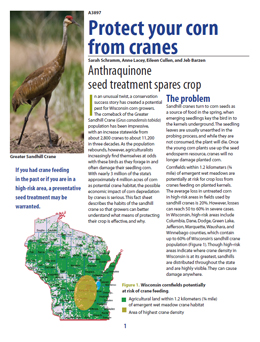How do you develop an effective, but non-toxic, repellent to prevent cranes from damaging corn crops?
Over the past 40 years, the population of Sandhill Cranes has grown dramatically in the upper Midwest, with birds moving into new locations and increasing in density in other areas. As the population has grown, farmers have experienced increasing damage to planted corn (the cranes feed on newly planted corn seeds). Traditional methods of crane deterrence, such as propane cannons that make loud noises, as well as other similar scare tactics, are not effective at preventing damage. On the contrary, these methods cause the cranes to move to other fields, thus not solving the problem at all.
In 1990, the International Crane Foundation began an intensive study of cranes in central Wisconsin, to better understand the natural history of these birds. One practical application of this study was to help solve the problem of cranes damaging newly sprouted corn seedlings. Describing and predicting where and when crop damage might occur is difficult, as cranes are highly mobile. We realized that we needed better information about how cranes use various habitats during the time of year when they do the most crop damage, from planting until the seedlings are about two weeks old. During the spring and early summer, cranes predominantly use wetlands for nesting and uplands, including meadows, pastures, and cultivated fields, for feeding.

To begin the crop damage research, we first contacted farmers to see if they had any success with preventing crane damage; several had. One farmer in the study area said that when he pre-treated corn with the insecticide Lindane, the cranes did not damage his germinating corn. We then began to track the use of Lindane by farmers and verified this finding. We also noted that, unlike traditional scare tactics, Lindane did not prevent cranes from continuing to forage in these fields. This behavior is beneficial to farming because cranes feed upon waste grain and harmful insects, such as beetle larvae, that can negatively impact yields.
However, there was still a problem. Lindane is a persistent, highly toxic, bio-accumulative chemical. Although we did not feel that Lindane was an ecologically sustainable solution until there was an alternative, there was no choice but to inform farmers that Lindane was effective at preventing crane crop damage. Next, we set out to identify and test the effectiveness of other, less toxic, compounds as deterrents.
We began testing alternative deterrents through field trials in our study area so that we could monitor crane habitat use. In those field trials, only one compound showed real promise – 9,10 anthraquinone (AQ). Preliminary trials showed AQ worked as effectively to prevent crane crop damage as Lindane. AQ is a compound naturally produced by plants to protect their fruit from being eaten before ripening. It has low toxicity and environmental impact.
With this breakthrough, we then focused on building a consortium of people to help move AQ through the federal regulatory process. Eventually, our collaborators included: the U.S. Environmental Protection Agency (EPA), the University of Wisconsin-Madison, the Wisconsin Department of Agriculture, Trade and Consumer Protection, Michigan and Minnesota agriculture departments, Michigan, Minnesota and Wisconsin Departments of Natural Resources, the Department of Wildlife Services (USDA), Former U.S. Senator Herb Kohl’s Office, the IR-4 Project of Rutgers University, Audubon Society, many local farmers, and Arkion, the manufacturer of Avipel® Shield in which the active ingredient is AQ.
The use of anthraquinone (AQ) to prevent crop damage by cranes is a win-win situation for both cranes and farmers. The use of AQ allows cranes to access critical food items in cultivated fields, such as waste grain and harmful insects, which are beneficial to the farmer. Additionally, farmers will not experience economic losses due to crop damage or have to handle toxic seed treatments. Successful solutions such as this example are critical for advancing wildlife conservation on private lands, which compose over two-thirds of North America’s land.
For more information on the availability of Avipel® Shield, please contact Arkion at 1-800-468-6324.

Click here to download the fact sheet “Protect your corn from cranes,” a joint publication of the International Crane Foundation and the University of Wisconsin–Madison/University of Wisconsin-Extension.
2016 was a record year for the use of Avipel® Shield with
116,374 acres treated in WI
3,790 acres treated in MI
11,625 acres treated in MN
In addition, other states are using Avipel® to deter damage from pheasants and various species of blackbirds in rice and sunflower seeds, as well as with corn. Final permission for the use of the deterrent (a Section 3 label) was applied for in October 2010, and we expect approval soon.[/vc_column_text][/vc_column][/vc_row]
